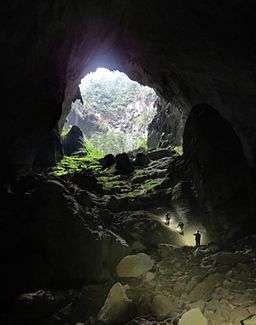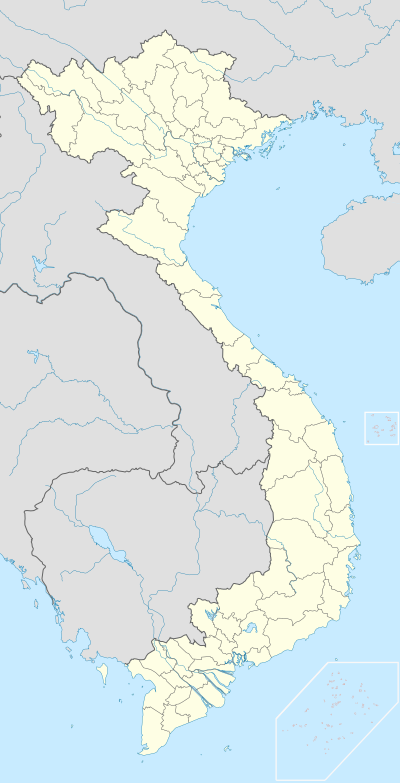Hang Sơn Đoòng
Sơn Đoòng cave (Vietnamese: hang Sơn Đoòng, IPA: [haːŋ˧ ʂəːn˧ ɗɔ̤ŋ˨˩]) is the world's largest natural cave,[1] in Phong Nha-Kẻ Bàng National Park, Bố Trạch District, Quảng Bình Province, Vietnam.
| Sơn Đoòng cave | |
|---|---|
| Hang Sơn Đoòng | |
 View approaching the second doline | |
 | |
| Location | Quảng Bình Province, Vietnam |
| Coordinates | 17°27′25″N 106°17′15″E |
| Depth | max. 150 metres (490 ft) |
| Length | approx. 9 kilometres (5.6 mi) |
| Discovery | 1991 [AD] by Hồ Khanh |
| Geology | Permo-Carboniferous limestone |
| Entrances | 2 |
| Hazards | Underground river |
| Cave survey | 2009, British/Vietnamese |
Located near the Laos–Vietnam border, Hang Sơn Đoòng has an internal, fast-flowing subterranean river and the largest cross-section of any cave, worldwide, as of 2009,[1][2] believed to be twice that of the next largest passage. It is the largest known cave passage in the world by volume.
Its name, Hang Sơn Đoòng, is variously translated from Vietnamese as 'cave of the mountain river'[3] or 'cave of mountains behind Đoòng [village]'.
As a solutional cave, it was formed in soluble limestone[4] and is believed to be between 2 and 5 million years old.[5]
Discovery
The entrance to Hang Sơn Đoòng was found in 1991 by a local man named Hồ Khanh, while searching for aloe, a valuable timber. The whistling sound of wind and the roar of a rushing stream issuing from the cave, heard through the entrance, as well as the steep descent, discouraged Hồ Khanh from entering the cave.[6]
Only in 2009 did the cave become internationally known after a group of cavers from the British Cave Research Association conducted a survey in Phong Nha-Kẻ Bàng from 10 to 14 April 2009.[3] Their progress was stopped by a large, 60-metre (200 ft) high flowstone-coated wall,[3] which was named the Great Wall of Vietnam. It was traversed in 2010 when the group reached the end of the cave passage.[7]
Description
Formed in Carboniferous/Permian limestone, the main Sơn Đoòng cave passage is the largest known cave passage in the world by volume – 38.4×106 cubic metres (1.36×109 cu ft), according to Howard Limbert. It is more than 5 kilometres (3.1 mi) long, 200 metres (660 ft) high and 150 metres (490 ft) wide. Its cross-section is believed to be twice that of the next largest passage, in Deer Cave, Malaysia.[8][9] The cave runs for approximately 9 kilometres (5.6 mi) and is punctuated by 2 large dolines, which are areas where the ceiling of the cave has collapsed. The dolines allow sunlight to enter sections of the cave, resulting in the growth of trees as well as other vegetation.[10]
By mid-2019, it became clear that the cave is connected by its underground river with a nearby cave called Hang Thung. This increases the effective volume of the cave by more than 1.6 million cubic metres.[11]
The cave contains some of the tallest known stalagmites in the world, which are up to 70 m tall. Behind the Great Wall of Vietnam were found cave pearls the size of baseballs, an abnormally large size.[12]
The scale of the site’s interior is so massive it could fit an entire New York block inside, including skyscrapers, or have a Boeing 747 comfortably fly through without its wings being in any danger.[13]
 Son Doong cave doline
Son Doong cave doline Another view out the mouth of the cavern, showing the rainforest in its doline.
Another view out the mouth of the cavern, showing the rainforest in its doline. Reflecting pool further inside
Reflecting pool further inside.jpg) Large stalagmites in the passage of Hang Son Doong in Vietnam. The tallest has been measured at 70 meters in height.
Large stalagmites in the passage of Hang Son Doong in Vietnam. The tallest has been measured at 70 meters in height..jpg) Large stalagmites in the Hang Son Doong, Vietnam. This passage is said to have the greatest cross sectional area of any cave in the world.
Large stalagmites in the Hang Son Doong, Vietnam. This passage is said to have the greatest cross sectional area of any cave in the world..jpg) The massive Second Doline in Hang Son Doong is so large that trees grow inside.
The massive Second Doline in Hang Son Doong is so large that trees grow inside.
Tourist activities
In early August 2013, the first tourist group explored the cave on a guided tour at a cost of US$3,000 each.[14] Permits are required to access the cave and are made available on a limited basis, with 1000 permits available for the 2019 and 2020 season, which runs from February to August.[15] After August, heavy rains cause river levels to rise and make the cave largely inaccessible. As of 2017 only Oxalis Adventure Tours have permission to enter the cave for tourism purposes.[16]
Development plans
Plans are being considered to build a cable car through the cave. The proposed system would be 10.5 kilometres (6.5 mi) long, and cost between $112 and $211 million. The plans are opposed by environmentalists.[17]
In popular culture
Alan Walker released a music video, Alone Pt. II, on December 27, 2019, depicting a young archaeologist on a quest to discover a place of mystery and wonder. After uncovering a hidden secret in a painting, she finds Quang Binh to be just the destination, mesmerized at the marvels of Sơn Đoòng.[13]
References
- "World's Biggest Cave Found in Vietnam". National Geographic. July 9, 2009. Archived from the original on February 28, 2015. Retrieved February 24, 2015.
- Guinness World Records 2013, Page 032. ISBN 9781904994879
- Dykes, Brett Michael (January 3, 2011). "Explorers discover spectacular caves in Vietnam". Yahoo!. Archived from the original on 2011-01-06.
- "Gerological Map of Vietnam, Kampuchea, and Laos". Retrieved 15 May 2014.
- Edström, Martin. "Fly Through A Colossal Cave: Son Doong in 360°". National Geographic. Retrieved 2017-10-07.
- Ho Khanh, a local farmer and biggest cave in the world at sondoongcave.org, accessed 23 June 2020
- Jenkins, Mark (January 2011). "Conquering an Infinite Cave". National Geographic. Retrieved 28 July 2018.
- "World's largest grotto unveiled in Vietnam". Archived from the original on 2009-04-27.
- "Britons claim to find world's largest cave". The Daily Telegraph. London. 30 April 2009.
- Son Doong Cave. "Son Doong cave, Hang Son Doong – Map".
- Springer, Kate (20 May 2019). "World's biggest cave is even bigger than we thought". CCN. Retrieved 26 June 2019.
- "Vietnam Cave". National Geographic. July 2011. Retrieved 16 January 2017.
- "Son Doong voted among world's seven wonders for 2020". VnExpress International.
- "First foreign tourist group explores Son Doong Cave". Foxnews. 2018-08-30. Retrieved 2013-08-08.
- "Son Doong Cave tours increase in popularity". 2015-01-15. Retrieved 2015-01-16.
- Letter 1213/UBND-VX, 2016-08-03, Government of Quang Binh Province.
- "Son Doong Cave cable car raises controversy". Vietnam.com. Retrieved 2017-01-16.
External links
| Wikimedia Commons has media related to Son Doong Cave. |
- "Vietnam's Mammoth Cavern". Retrieved 2010-12-21. National Geographic pictorial of Hang Sơn Đoòng
- "American Film Crew's Backstage Inside Son Doong". Retrieved 2015-05-18. Saigon-online-SonDoong-cave
- Strutner, Suzy (September 7, 2013). "World's Largest Cave, Son Doong, Prepping For First Public Tours" (includes video). The Huffington Post. Retrieved September 11, 2013.
- Chùm ảnh khám phá hang động đẹp và lớn nhất thế giới(includes images) Quảng Bình Province (in Vietnamese)
- "In pictures: Inside Hang Son Doong, the world's largest caves in Vietnam". Retrieved 2014-06-20. The Telegraph Online
- "Hang Son Doong" (video on Vimeo). Retrieved March 17, 2015.
- "National Geographic Video March 19, 2015".